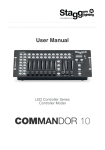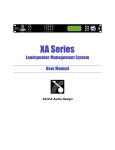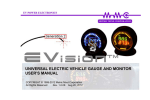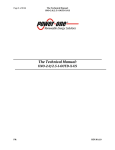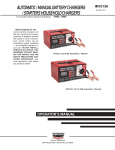Download Neon_downloads_files/NE-1 User Manual 1.0
Transcript
Neon Lamp Driver Model NE-1 User and Technical Manual Copyright 2008-9 Aurora Design LLC. Revision 1.2 10 February, 2009 All specifications subject to change www.tech-retro.com Introduction Introduction This manual covers the operation and technical aspects of the NE-1 Neon Driver. The driver is designed to take a 10-20Vdc input, raise it to 350Vdc, and current modulate a video input onto a Neon Plate or Crater Lamp. Features • Compact, low power, surface mount design • Front panel Status LED’s for high voltage, temperature and efficiency status • Internal user switch selectable current limit • High efficiency switching supply generates 350V open circuit, and 66ma @ 250V • High voltage, current controlled MOSFET output • Over-temperature protection • Direct connection to WC-01 (WC-01D option not required) • Drives all original Neon Plate and Crater Lamps • Versatile I/O: - Video Input (1Vpp, 75 ohm, 500KHz) - Neon Output (350V maximum, 66ma maximum @ 250V) - DC power (10-20Vdc, 19W) Front Panel The front panel is shown below: Voltage Clip Set LED Status LED 3 Introduction Status LED: The status LED conveys the current operating state of the driver. Green: Driver powered but no Neon cable attached. No High Voltage present at output. Red: Driver Powered and Neon cable attached. High Voltage present at output! Yellow: Driver powered and Neon cable attached, but driver is over temperature. No High Voltage present at output. Clip LED / Voltage Set: The Voltage Set control adjusts the open circuit voltage between 115V and 350V. The Clip LED shows when the Power MOSFET output is clipping the video signal to the Neon Lamp. The Voltage Set control should always be set to minimum (maximum counter clockwise) and then adjusted upwards until the Neon Lamp fires, and the Clip LED is just extinguished. Turning the Voltage Set higher than this point will not affect the performance of the driver in any way, but may cause the driver to go into thermal shutdown due to the power MOSFET operating inefficiently. Never set the Voltage Set any higher than is necessary to extinguish the Clip LED. Rear Panel The rear panel is shown below: Video Input Neon Output 4 Vdc Input Introduction Video Input: This RCA or BNC connector provides the video input to the driver. This input is terminated into a 75 ohm load. The input accepts a 1Vpp video signal. This signal should be DC coupled, and contain only the luminance information. This means there should not be any sync or chroma information in this signal. Black should be at 0.0V and peak white should be at 1.0V. For complete information about the characteristics of this output, please refer to the Specifications section found later in this manual. Neon Output: The 3 pin Mini-DIN Neon Output connector connects the driver to the neon lamp. One pin has the high voltage signal on it, one pin has the grounding current signal, and one pin is ground. The high voltage and current signal are wired to the neon lamp using wire rated for at least 350V. The ground signal is supplied only if a shielded cable is used, but is normally left unconnected. Since the cable will be carrying a high voltage, high frequency signal, it should be of a low capacitance type. While a higher capacitance cable can be used, a fair amount of power will be wasted in this capacitance and not make it to the neon lamp. Caution! Because this driver has the capability to generate up to 350V and up to 66ma it can be very dangerous. The Neon Output Connector should never be attached or removed with the unit powered up, and the wiring to the neon lamp must be rated for this voltage or higher. Only people familiar with working around high voltages should connect or operate this unit! Power: The driver requires a power source of between 10 and 20 volts DC at 19W maximum. The exact amount of power required depends on the internal current limit settings, and the operating voltage of the Neon Lamp. This power can be supplied by an optional cable connected to the Switched Power Output on the WC-01 World Converter. The unit has a fused input, so it will not be damaged by reversal of polarity, or over voltage, but it will blow the fuse. The unit uses a standard 2.1mm X 5.5mm, center positive, coaxial power connector as found on most consumer electronic equipment. Internal Options The internal Options switch is shown below: 5 Introduction Back of unit (Connectors) Front of unit (LEDʼs, Volt Set) S1 Clip LED ON 1 2 Volt Set Option Switch Status LED The internal Option Switch S1 has two controls allowing the user to set the current limit of the driver. In order to change the switch settings, the cover must be removed from the unit. To do this, first remove all cables from the unit, including the power cable. Place the unit on it’s top, and remove the two, small phillips screws from the bottom. Flip the unit back over, and remove the top. Caution! In the subsequent steps, make sure you are touching the outer metal ring on the phono connector to discharge any static electricity that may be present before proceeding. There are static sensitive devices inside the converter that can be damage if subjected to a static discharge. Failure to follow this procedure will result in damage to the unit! Using a small tool such as a paper clip, carefully slide the desired switch to it’s new position being careful to not put an undue amount of force on the switch that might damage it or the circuit board. Once the desired switch settings have been achieved, replace the cover on the unit, and reinstall the two phillips screws. There are four possible current limits that can be set for the driver as shown in the table below: 6 Introduction SW1 SW2 Switch position OFF OFF ON ON OFF ON OFF ON 25ma current limit 40ma current limit 50ma current limit 66ma current limit These switches should be set to the current rating of the neon lamp being used. If the rating of the lamp is unknown, it’s better to use a lower setting although this will create a dimmer image. Operating Modes The video supplied to the driver is of a standard 1Vpp signal driving into a 75 ohm load. It does differ however from normal composite video as it should only contain the luminance information, and not contain any sync or chroma data. This data would end up in the neon image and spoil the quality. The video should be DC coupled to the driver with 0.0V representing black, and 1.0V representing peak white. The input is automatically clamped at 1.2V and will not allow a higher level signal through. This is required to limit the current, and potential damage to the neon lamp. Before powering the unit up, the Voltage Set control should be turned maximum counter clockwise. This will force the high voltage supply to a minimum voltage. When power is applied to the driver and no neon cable is attached, the Status LED will show green. This signifies that the unit is powered, but no high voltage is being generated. When a neon cable is attached, the driver will sense this, and enable the high voltage supply. The Status LED will then show red to signify that high voltage is being generated, and care must be taken. If at anytime during operation the neon cable is removed, the Status LED will return to green, and the high voltage supply will be disabled. With the unit powered, a neon lamp attached, and a video source that meets the requirements as described in the Specifications section of this manual, the Voltage Set control can be adjusted for normal operation. Starting with the control maximum counter clockwise, the neon lamp may or may not be lit. Slowly turn the control clockwise until the neon lamp is lit, and the Clip LED is completely turned off. This will set the operating point of the current driver to it’s most efficient. While no harm will come to the driver or the neon lamp if the Voltage Set control is advanced to far, it will waste power, and may cause the driver to go into thermal shutdown. If the driver does go into thermal shutdown, the Status LED will show yellow, the high voltage supply will be disabled, and you will need to wait for the driver to cool off before it will resume normal operation. (If this happens, the Voltage Set control should be readjusted as described above.) You do not need to remove power or the neon cable during a thermal overload as the driver will protect itself and will automatically return to normal operation when the internal temperature drops. Once the Voltage Set, control is adjusted, it should not need to be readjusted again 7 Introduction unless the neon lamp is changed. If the lamp is changed, just perform the previous mentioned procedure to readjust the control for the new lamp. Note: If the wrong side of the Neon Plate lamp is illuminated, you need to swap the leads on the lamp. This will cause the other plate, or other side of a single plate to illuminate. Note: Due to the magnetics used in the driver, there may be a slight noise emitted from the driver in sync with the video. This is normal in drivers of this type and does not affect its operation. If the driver is being used in conjunction with a WC-01 World converter, you only need to connect the supplied video and power cables from the driver to the Switched Power and Mechanical RGB Output of the WC-01. The optional WC-01D daughter card is not required for use with the NE-1 driver. Caution! Because this driver has the capability to generate up to 350V and up to 66ma it can be very dangerous. The Neon Output Connector should never be attached or removed with the unit powered up, and the wiring to the neon lamp must be rated for this voltage or higher. Only people familiar with working around high voltages should connect or operate this unit! Block Diagram Thermal Protection High Voltage Enable Po wer Input High Voltage Switching Power Supply Current Foldback Video Input High Frequency Power MOSFET Current Driver 8 Neon Output Introduction Pinouts Neon Output: 3 2 1 1 - High Voltage Power 2 - Current Output 3 - Ground Specifications Video Input: Video Input: 1Vpp, 75 ohm impedance Video Bandwidth: 500KHz -3dB Neon Output: Output Voltage: adjustable from 115V to 350V open circuit Output Current: adjustable limit of 25ma, 40ma, 50ma and 66ma Output Power: 16.6W (66ma @ 250V) maximum General: Dimensions: 2.60” X 2.60” X 1.00” (66mm X 66mm X 25mm) Weight: 3.0oz (85g) Power Requirements: 18Vdc typical, 10-20Vdc maximum 19 watts typical (full load) Temperature Limit: 75°C rising trip point, 65°C falling reset point Humidity: 20% - 80% non-condensing Temperature: 10C - 40C ambient (50F - 104F) 9 Revision History Revision History Revision 1.2, 10 February, 2009: 1) Initial release. Note: Hardware revision level can be found on bottom label of unit. 10










